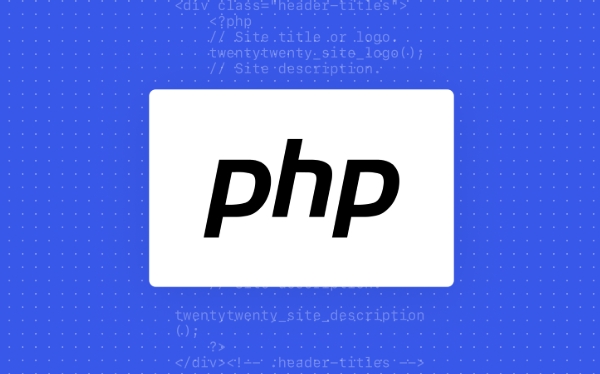A Deep Dive into PHP's Array Append Mechanisms Under the Hood
Aug 02, 2025 pm 12:19 PMWhen you use $array[] = $value in PHP, the Zend Engine appends the value using the next integer key, determined by the cached nNextFreeElement in the HashTable structure, starting from 0 for empty arrays. 2. The operation begins with opcode execution (e.g., ASSIGN_DIM), followed by a check for writeability, triggering copy-on-write if the array’s refcount > 1, which may cause an O(n) duplication. 3. The engine inserts the value into a Bucket within the HashTable using a precomputed key, without scanning due to the cached next free index. 4. If the HashTable is full, PHP resizes it to the smallest power of 2 greater than 1.5 × current size, rehashes all elements, and frees the old table, resulting in O(n) cost but amortized O(1) over time. 5. Performance is optimized through packed array storage for consecutive integer keys, improving cache efficiency, and modern PHP versions enhance speed via better hashing, reduced overhead, and JIT compilation in loops. 6. Pitfalls include unexpected key assignment after high-index manual inserts, performance drops during resizing or when copying large shared arrays, and memory inefficiencies in uncontrolled growth scenarios.

When you write $array[] = $value; in PHP, it feels effortless — a simple way to append data to an array. But beneath that clean syntax lies a complex and highly optimized system rooted in PHP’s internal engine, Zend Engine. Understanding how PHP handles array appending under the hood reveals insights into performance, memory management, and design trade-offs.

Let’s take a deep dive into what happens when you append to an array in PHP — from the userland syntax down to the C-level implementation in the Zend Engine.
How PHP Arrays Work Internally
Despite being called “arrays,” PHP arrays are actually ordered hash maps (or dictionaries). They can have integer or string keys, support mixed types, and maintain insertion order. This flexibility comes from their implementation as hashtables in the Zend Engine.

Each PHP array is represented by the HashTable structure in C. This structure contains:
- A bucket array (the actual storage)
- Hash function and lookup logic
- Metadata like size, number of elements, and collision chains
When you append using $array[] = $value;, PHP interprets this as “insert with the next available integer key,” starting from 0 and incrementing automatically.

Step-by-Step: What Happens on $array[] = $value
Zend Engine Receives the Opcode When PHP compiles your script,
$array[] = $valuetranslates into an opcode likeASSIGN_DIMorADD_ARRAY_ELEMENT, depending on context. The executor then calls the appropriate handler.Check if the Array is Writeable PHP checks whether the array is a reference or shared (via copy-on-write). If the array has a refcount > 1, it will be copied before modification to preserve data integrity (known as separation).
-
Determine the Next Integer Key The Zend Engine scans the array to find the highest consecutive integer key currently in use. It then uses
max(key) 1as the new key — unless the array is empty, in which case it starts at 0.Note: This scan is not linear. PHP caches the next free element in the
HashTablestructure (nNextFreeElement) to avoid scanning every time. -
Insert the Value into the HashTable The engine prepares a
Bucket(the structure holding key, value, and hash chain pointers), fills it with:- The calculated integer key
- A
zvalcontainer for the value (which may be duplicated if needed) Then inserts it into the hash table using internal hash functions.
-
Handle HashTable Resizing (if needed) If the bucket array is full (based on
nNumOfElementsvs.nTableSize), PHP resizes the HashTable:- Allocates a larger bucket array (typically doubling in size)
- Rehashes all existing elements into the new structure
- Frees the old bucket array
This operation is O(n) but happens infrequently due to exponential growth — making average insertions amortized O(1).
Memory Allocation and Performance
PHP uses a smart growth strategy to minimize reallocations:
- HashTable sizes grow in powers of 2 (e.g., 8, 16, 32, ..., up to a threshold)
- When resizing, the new size is the smallest power of 2 greater than 1.5 × current size
- This reduces fragmentation and ensures amortized constant-time inserts
For example:
$array = [];
for ($i = 0; $i < 100000; $i ) {
$array[] = $i;
}This loop performs efficiently because:
- No manual key management
- Cached next key via
nNextFreeElement - Resizing happens only ~17 times (log? growth)
But if you pre-allocate or avoid appending in loops unnecessarily, you can do even better.
Pitfalls and Gotchas
Even though appending looks simple, some behaviors can surprise developers:
1. Non-Sequential Integer Keys
If you manually set a high key like $array[1000] = 'x';, then use $array[] = 'y';, PHP will use 1001 as the next key — even if indices 0–999 are empty.
This is because nNextFreeElement tracks the highest integer key ever used, not the first gap.
2. Performance with Large Arrays
While amortized O(1), each resize can cause a noticeable pause. For performance-critical code, consider:
- Pre-sizing arrays when possible (though PHP doesn’t expose direct control)
- Using SplFixedArray when working with large, integer-indexed data
3. Copy-on-Write Overhead
Appending to an array that's shared (e.g., passed by value) may trigger a full copy:
$a = range(1, 100000); $b = $a; // refcount = 2, no copy yet $b[] = 'new'; // triggers full array duplication!
This makes the append O(n) in this specific case.
Optimizations in Modern PHP (7.4 )
Recent PHP versions have significantly improved array performance:
- Packed Arrays: When an array uses only consecutive integer keys and no string keys, PHP may store it more compactly (similar to a C array), improving cache locality and iteration speed.
- JIT (PHP 8 ): While JIT doesn’t directly speed up array appends, tight loops involving appends benefit from reduced interpreter overhead.
- Improved Hash Functions: Better hashing reduces collisions, improving lookup and insert speed.
You can check if an array is "packed" internally using reflection or low-level tools — though not exposed directly in userland.
Summary
Appending to a PHP array with $array[] = $value involves:
- Efficient key calculation using cached metadata
- Fast insertion via the Zend HashTable
- Amortized O(1) performance thanks to exponential resizing
- Potential overhead from copy-on-write or non-sequential keys
While the syntax is deceptively simple, the underlying mechanism is a carefully tuned balance of flexibility and speed.
So next time you push data into a PHP array, remember: there’s a lot more going on than meets the eye — and it’s mostly working in your favor.
The above is the detailed content of A Deep Dive into PHP's Array Append Mechanisms Under the Hood. For more information, please follow other related articles on the PHP Chinese website!

Hot AI Tools

Undress AI Tool
Undress images for free

Undresser.AI Undress
AI-powered app for creating realistic nude photos

AI Clothes Remover
Online AI tool for removing clothes from photos.

Clothoff.io
AI clothes remover

Video Face Swap
Swap faces in any video effortlessly with our completely free AI face swap tool!

Hot Article

Hot Tools

Notepad++7.3.1
Easy-to-use and free code editor

SublimeText3 Chinese version
Chinese version, very easy to use

Zend Studio 13.0.1
Powerful PHP integrated development environment

Dreamweaver CS6
Visual web development tools

SublimeText3 Mac version
God-level code editing software (SublimeText3)
 PHP Variable Scope Explained
Jul 17, 2025 am 04:16 AM
PHP Variable Scope Explained
Jul 17, 2025 am 04:16 AM
Common problems and solutions for PHP variable scope include: 1. The global variable cannot be accessed within the function, and it needs to be passed in using the global keyword or parameter; 2. The static variable is declared with static, and it is only initialized once and the value is maintained between multiple calls; 3. Hyperglobal variables such as $_GET and $_POST can be used directly in any scope, but you need to pay attention to safe filtering; 4. Anonymous functions need to introduce parent scope variables through the use keyword, and when modifying external variables, you need to pass a reference. Mastering these rules can help avoid errors and improve code stability.
 How to handle File Uploads securely in PHP?
Jul 08, 2025 am 02:37 AM
How to handle File Uploads securely in PHP?
Jul 08, 2025 am 02:37 AM
To safely handle PHP file uploads, you need to verify the source and type, control the file name and path, set server restrictions, and process media files twice. 1. Verify the upload source to prevent CSRF through token and detect the real MIME type through finfo_file using whitelist control; 2. Rename the file to a random string and determine the extension to store it in a non-Web directory according to the detection type; 3. PHP configuration limits the upload size and temporary directory Nginx/Apache prohibits access to the upload directory; 4. The GD library resaves the pictures to clear potential malicious data.
 Commenting Out Code in PHP
Jul 18, 2025 am 04:57 AM
Commenting Out Code in PHP
Jul 18, 2025 am 04:57 AM
There are three common methods for PHP comment code: 1. Use // or # to block one line of code, and it is recommended to use //; 2. Use /.../ to wrap code blocks with multiple lines, which cannot be nested but can be crossed; 3. Combination skills comments such as using /if(){}/ to control logic blocks, or to improve efficiency with editor shortcut keys, you should pay attention to closing symbols and avoid nesting when using them.
 How Do Generators Work in PHP?
Jul 11, 2025 am 03:12 AM
How Do Generators Work in PHP?
Jul 11, 2025 am 03:12 AM
AgeneratorinPHPisamemory-efficientwaytoiterateoverlargedatasetsbyyieldingvaluesoneatatimeinsteadofreturningthemallatonce.1.Generatorsusetheyieldkeywordtoproducevaluesondemand,reducingmemoryusage.2.Theyareusefulforhandlingbigloops,readinglargefiles,or
 Tips for Writing PHP Comments
Jul 18, 2025 am 04:51 AM
Tips for Writing PHP Comments
Jul 18, 2025 am 04:51 AM
The key to writing PHP comments is to clarify the purpose and specifications. Comments should explain "why" rather than "what was done", avoiding redundancy or too simplicity. 1. Use a unified format, such as docblock (/*/) for class and method descriptions to improve readability and tool compatibility; 2. Emphasize the reasons behind the logic, such as why JS jumps need to be output manually; 3. Add an overview description before complex code, describe the process in steps, and help understand the overall idea; 4. Use TODO and FIXME rationally to mark to-do items and problems to facilitate subsequent tracking and collaboration. Good annotations can reduce communication costs and improve code maintenance efficiency.
 Quick PHP Installation Tutorial
Jul 18, 2025 am 04:52 AM
Quick PHP Installation Tutorial
Jul 18, 2025 am 04:52 AM
ToinstallPHPquickly,useXAMPPonWindowsorHomebrewonmacOS.1.OnWindows,downloadandinstallXAMPP,selectcomponents,startApache,andplacefilesinhtdocs.2.Alternatively,manuallyinstallPHPfromphp.netandsetupaserverlikeApache.3.OnmacOS,installHomebrew,thenrun'bre
 How to access a character in a string by index in PHP
Jul 12, 2025 am 03:15 AM
How to access a character in a string by index in PHP
Jul 12, 2025 am 03:15 AM
In PHP, you can use square brackets or curly braces to obtain string specific index characters, but square brackets are recommended; the index starts from 0, and the access outside the range returns a null value and cannot be assigned a value; mb_substr is required to handle multi-byte characters. For example: $str="hello";echo$str[0]; output h; and Chinese characters such as mb_substr($str,1,1) need to obtain the correct result; in actual applications, the length of the string should be checked before looping, dynamic strings need to be verified for validity, and multilingual projects recommend using multi-byte security functions uniformly.
 Learning PHP: A Beginner's Guide
Jul 18, 2025 am 04:54 AM
Learning PHP: A Beginner's Guide
Jul 18, 2025 am 04:54 AM
TolearnPHPeffectively,startbysettingupalocalserverenvironmentusingtoolslikeXAMPPandacodeeditorlikeVSCode.1)InstallXAMPPforApache,MySQL,andPHP.2)Useacodeeditorforsyntaxsupport.3)TestyoursetupwithasimplePHPfile.Next,learnPHPbasicsincludingvariables,ech






